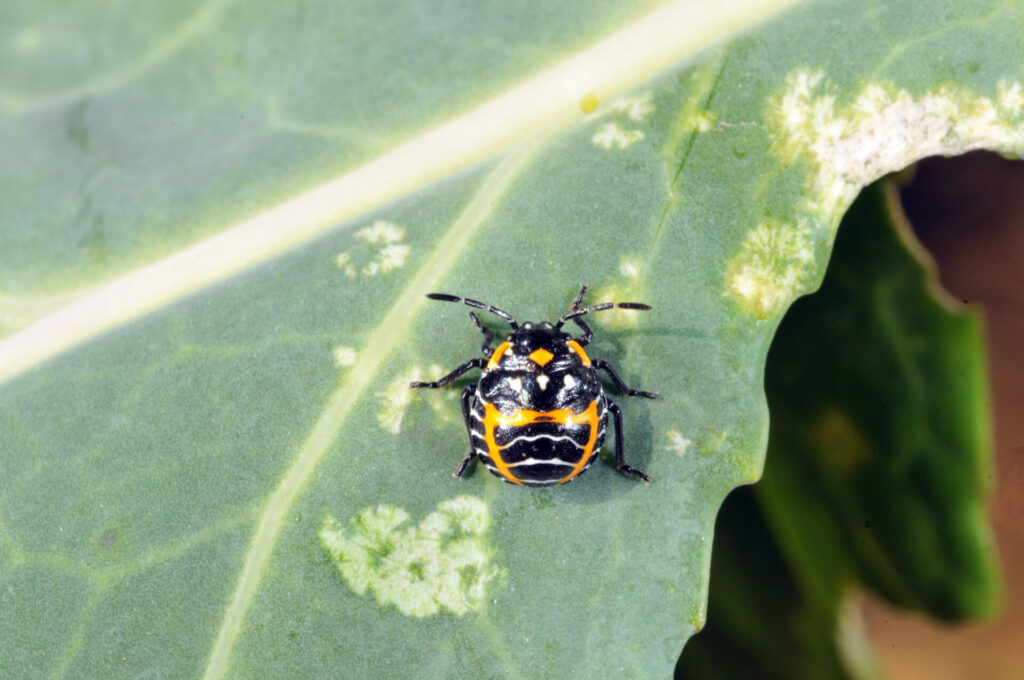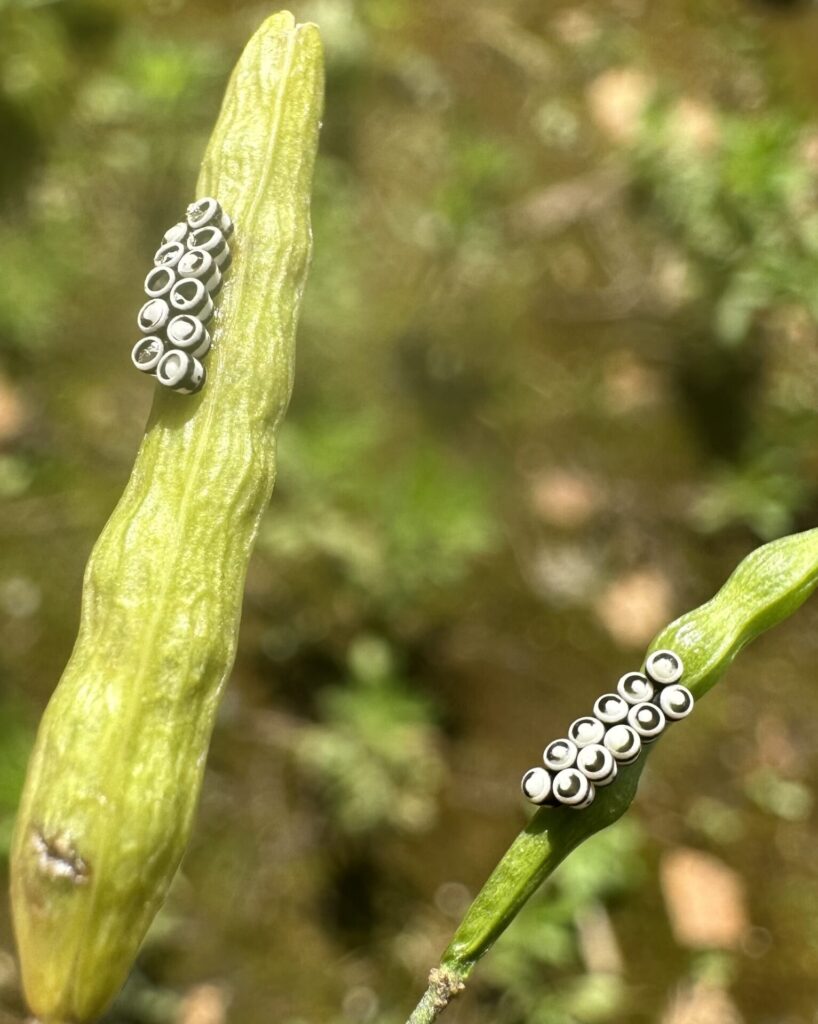If you haven’t had the pleasure, please allow me to introduce you to the Harlequin bug, Murgantia histronica (Figure 1). This true bug (Order Hemiptera) is equipped with piercing-sucking mouthparts and has a preference for feeding on brassica crops. Unfortunately for us, their feeding results in white blotches on the leaf tissues (Figure 2), and under high pest pressure, leaf necrosis and plant death. Let me help you become familiar with this pesky critter so that you can more easily recognize and manage this pest.

Figure 2. Harlequin nymph on a cabbage leaf with distinct white markings resulting from their feeding (Photo by John Obermeyer).
Life Cycle
Harlequin bugs (aka calico bug, fire bug or harlequin cabbage bug) belong to the family Pentatomidae, adding to the catalog of stink bugs that can cause damage to crop production. And like most other stink bugs, this one overwinters as adults under the shelter of crop debris. Historically, the northern limit for overwinter survival of this pest was 40° N latitude, putting Indiana right on this border. However, with milder winters and shifts in USDA hardiness zones, this pest is likely to experience higher overwintering survival in our state. When conditions are favorable (i.e., mild winters), you can see all life stages present during this time. In the spring, large aggregations of adults form as they begin to mate and lay eggs. The eggs are laid in clusters on host plants and have a distinct shape that can help with recognition (double rows of six, barrel-shaped, and black and white striped), distinguishing them from egg masses of beneficial insects like ladybeetles (orange oblong clusters) (Figure 3). Eggs are often found on the underside of leaves or on seed pods. The eggs hatch and small nymphs emerge that are orange-red with black markings. This occurs in as little as three days up to as many as 20, depending on temperature. The nymphs (Figure 2) will transition through five instars (stages) until they reach adulthood. Both nymphs and adults feed on host plants with their piercing-sucking mouthparts.

Figure 3. Harlequin eggs are laid in clusters on host plants and have a distinct shape that can help with recognition (Photo by John Obermeyer).
Host Plants
While they are brassica specialists, they can feed on over 50 species of plants. Harlequin bugs often exhibit preferences for particular types of brassica crops, including mustards, turnips, and Chinese cabbage. This host plant preference can be used for cultural control tactics (see below). They will feed on many common brassica weeds, including wild mustard, shepherd’s purse, and watercress, as well as other brassica weed species. Additionally, they will consume non-brassica weeds such as common pigweed and lambsquarters.
Management Options
Using cultural control tactics should be your first step to minimize the damage inflicted by this pest. Crop destruction from the previous year is one way to minimize the overwintering populations. However, with the increased adoption of cover cropping and incorporation of brassicas in these mixes, destroying your vegetable residue may mean very little if you are growing near large fields that utilize these cover crops. If possible, delaying planting OR physically covering early brassica plantings to prevent any overwintering populations on nearby cover crop fields can protect that susceptible crop at the time the cover crops are harvested. Trap cropping has also been effective in minimizing their damage. Planting early broccoli or the other preferred crops mentioned above can help aggregate populations in the spring. Action must be taken on these trap crops to manage the population and thus protect later plantings.
The bright coloration of this bug serves as nature’s natural warning that they are not good to eat, and thus, biological control of this pest is difficult. In addition to sequestering glucosinolates from the host plants it feeds upon, it also produces several other defensive warning chemicals that it emits from its body when threatened or attacked. However, three species of parasitoids have been recorded attacking this pest in the U.S. Unfortunately, none of these are commercially available, and surveys have documented parasitism rates ranging from 8% to 50%, with an average of around 13% of total eggs.
Chemical control, therefore, is often the most effective option; however, the need for it can be minimized by first utilizing the cultural control method mentioned above. For organic growers, Spinosad has been demonstrated to be most effective, but pyrethrin and azadirachtin are also labeled. Synthetic chemicals, including pyrethroids, carbamates, and neonicotinoids, have proven effective. All of these are detrimental to beneficial insect communities (pollinators and natural enemies) and therefore should be used cautiously. Targeted soil applications can be most effective and provide longest protection but use the lowest label rates and do not apply in areas where water runoff is likely to enter waterways or if a rain event is expected, as they are highly water soluble and will move out of the root zone and into the surrounding environment and vegetation. Whether using organic or synthetic foliar products, a surfactant should be incorporated to achieve good coverage on the waxy surface of brassica plants.
This year I am evaluating the efficacy of a compound that targets piercing-sucking insects in hopes of identifying a product that is effective against this pest and minimizes the impact on beneficial insects. The product is flonicamid and has great efficacy against aphids, often with one application offering season-long control.
If you have harlequin bugs on your farm, please let me know! I would love to come collect them for my trials! lingwell@purdue.edu or 765-494-6167.
